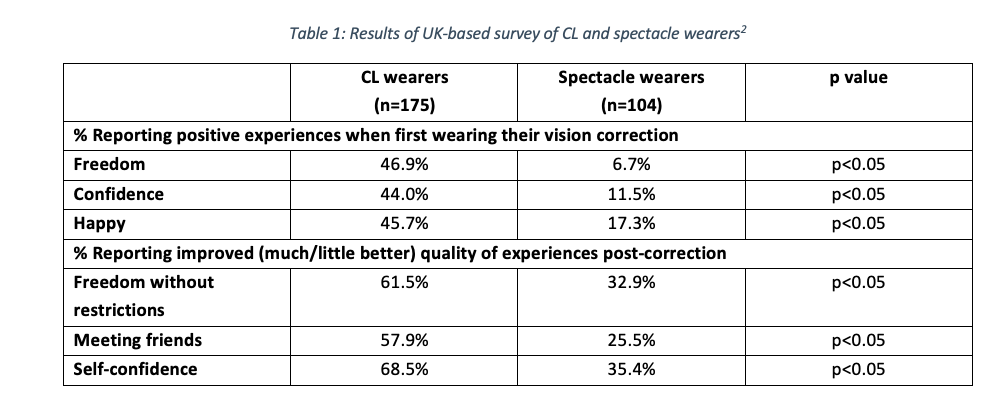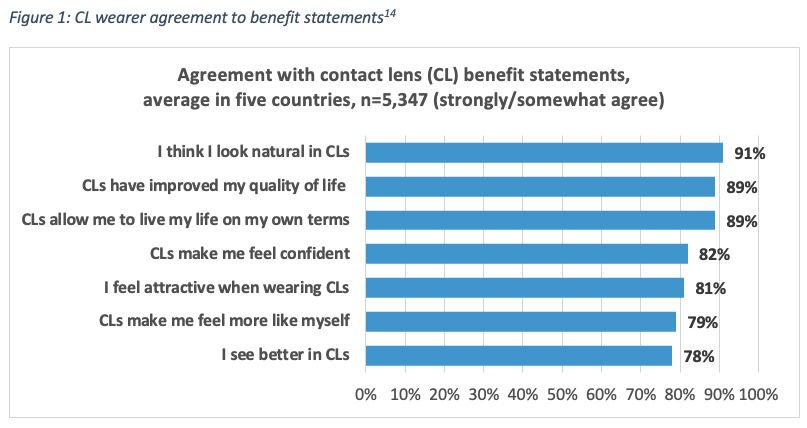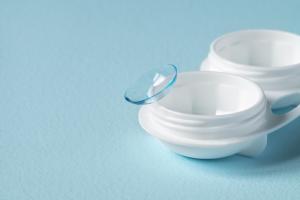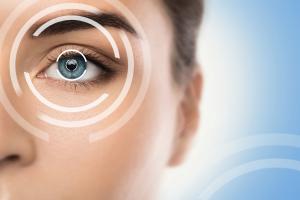Part 1 of this 2-part series shares new insights which tell the story of the deeper emotional benefits contact lens wearers feel, and how eye care professionals can use that understanding to increase proactive recommendation, creating many more satisfied dual wearers of both spectacles and contact lenses. New data on contact lens wearer habits in combination with face masks are also shared in this 2-part article.
Introduction
The majority of people who require vision correction are spectacle-only wearers. Best estimates suggest that in the US, just over one-quarter of these are dual wearers (27%), choosing to correct their vision with both spectacles and contact lenses (CLs).1 This proportion varies by country; estimates for the UK suggest a lower number, just 17.8% of vision corrected consumers also wear CLs.2 Whatever the actual figure by market, globally there is no doubt that use of spectacles as the only form of vision correction far exceeds CL wear and is usually the default option, and often the only, offered by eye care professionals (ECPs).
Historically, this fitting behaviour may have been driven by a combination of CL availability and clinical performance. ECPs are aware though that modern frequent replacement soft CLs are available in prescription ranges that fit most patients, with comfort levels which should enable many more people to become CL wearers. So, if not a lack of choice and technology, what else drives apparent underuse of CLs? A gap in communication exists between patients and ECPs, with the former expecting their professional to recommend CLs as an option if they were suitable, and the latter often reacting only to a patient who thinks to ask about contacts. It has been shown across a number of studies that either the proactive recommendation of CLs to all patients,3-5 or the offer of a CL experience whilst choosing new spectacles,8 When questioned, the feedback from those living with refractive error highlights a number of themes that impact quality of life, including concerns about cosmetic appearance and ocular health, and difficulty performing day-to-day activities.9
The positive benefits of CL wear have been explored in young myopes. When compared to spectacles, those fitted with soft CLs over a three year period reported improved physical appearance, athletic competence and social acceptance.10 Significant differences in vision-related quality of life were also reported, especially for activities, appearance, and satisfaction with correction.11 Fitting teenagers with daily disposable CLs resulted in improved quality of life scores after just one month, with significant improvements compared to a spectacle wearing group in appearance, activities, peer perception and overall score.12
Quality of life with vision correction, UK study
While good evidence exists for the younger ametropic cohort, less is known about how adults feel about themselves when they wear CLs. Recent surveys have been conducted to expand knowledge in this area. Prompted by recognition that the proportion of CL wearers is not rising in the vision corrected population, one study explored the behaviours, motivations and perceived benefits of CLs among 104 spectacle wearers and 175 CL wearers in the UK.2 The online survey, conducted in May 2018 asked subjects about what was important in their lives, how those experiences were altered by their vision correction, the impact of wearing spectacles initially, and their opinions on the advice their ECP had given regarding CL suitability.
When wearing their correction for the first time, significant differences existed between the spectacle only and CL wearing groups. At least 2.5 times more CL wearers reported positive feelings such as experiencing freedom, feeling confident and happy compared to spectacle only wearers (Table 1).2 Beyond those initial impressions, significant differences also existed for feeling a sense of “freedom without restrictions”, improved experiences when “meeting friends” and increased self-confidence. Significantly more CL wearers stated they loved their correction (78.9% vs 27.9%) and that it had transformed their life (79.4% vs 45.2%). Of the 132 subjects that were considered ‘dual wearers’ of spectacles and CLs, more than eight out of ten (81.1%) felt that having the option of both forms of vision correction gave them the best of both worlds. This feedback should perhaps be viewed not only in the light of CL wear making patients feel good, but perhaps, conversely, recognizing the opposite: that for some, wearing spectacles does not instil such positive emotions. Awareness of this can help ECPs counsel patients both on how best to adjust to spectacles, whilst serving as a good reminder to also mention the option of CLs.

Differences also existed between the two groups in relation to their ECP. CL wearers were more likely to think highly of their ECP who told them they were suitable for CLs as well as spectacles (72.6% vs 44.2%) and more likely to recommend that ECP compared to the spectacle only wearing group (63.4% vs 30.8%). Most consumers, irrespective of vision correction, expected their ECP to advise about their CL suitability (80.0% CL group and 63.5% spectacle group) however, ECPs only suggested CLs to less than one-third of wearers (31.4%). This result echoes the problem highlighted in the opening of this article of the gap that exists between what consumers expect their ECP to do in relation to vision correction recommendations and what actually happens in practice.13
Deeper benefits of contact lenses; multi-country survey
A survey conducted by YouGov (Nov-Dec,2019) sought to understand the deeper benefits of CL wear in a large sample of consumers in five different countries. Approximately one thousand CL wearers responded in each of Germany, Great Britain, Japan, Spain and the United States, over one-third wore daily disposable lenses, over half wore lenses for more than eight hours a day and nearly two-thirds were classed as frequent wearers (Table 2).14 CL respondents were asked their level of agreement to a series of statements, with the results reporting the proportion of those agreeing to statements (strongly agree/ somewhat agree). Minimal differences existed between countries for the majority of statements.

The results reflect those of the UK study from 2018, with 89% agreeing that CLs have “improved their quality of life” and “allow them to live their life on their own terms”.14 The highest level of agreement was to the statement “I think I look natural” (91%), with a number of other deeper emotional benefits experienced by around eight out of ten wearers (Figure 1). These included feeling attractive when wearing CLs and feeling confident.

Visual benefits of contact lenses
CL wearers have high expectations of their ECP when it comes to vision. Regardless of cost, 86% agreed they expect their ECP to make a recommendation for the soft CLs that provide the best possible vision correction for their eyes.14 This result echoes previous work relating to the health performance of CLs where nearly 7 out of 10 agreed that they expect their ECP to recommend the lenses that provide 100% of the oxygen that their eyes need, again, regardless of cost.13 These simple wishes from consumers should give confidence to ECPs that they can recommend the most clinically appropriate CLs to patients, and allow patients themselves to make an informed choice.
The visual benefits of CLs produced an interesting result in the survey. Nearly eight out of ten CL wearers agreed with the statement “I see better in CLs”. Such high levels of patient satisfaction with their vision may be surprising to some ECPs. For example, recently generated data from US ECPs found on average just 50% felt correction with soft toric lenses provides the same visual acuity as a patient’s up to date spectacle prescription.15 It is also noteworthy that the high level of agreement for “seeing better in CLs” held true for the presbyopic group aged 55 and over.14 This age group requires multifocal CLs, monovision or additional near vision spectacles to correct their vision fully. Younger people however are more likely to purchase contact lenses, with 17% of 16-24 year olds, and 14% of 25-34 year old compared to just 5% of 45-54 year olds saying they had done so within the last two years.16 The relatively low penetration of CL use for the presbyopic age group perhaps suggests that ECPs are more concerned CL success is harder to achieve with these patients, with poor vision being one of the reasons for that. In that context, the positive visual benefits reported by presbyopes in the survey are encouraging to help ECPs feel confident to recommend CLs more routinely to this group of patients. Overall, it should be recognised that the visual benefits experienced by lens wearers likely go beyond high contrast Snellen acuity, instead encompassing a more general sense of visual freedom through no loss of peripheral vision related to the spectacle frame, and for presbyopes potentially, gaze-independent viewing.
Consistent benefits across groups
It is interesting to note that the high levels of agreement to statements reported by CL wearers were fairly consistent between different patient groups.There was no more than a 3% difference in agreement between men and women for the emotional benefits of CL wear. This included feeling confident, attractive and experiencing an improved quality of life.14 This knowledge is useful to in practice: keeping front of mind that men report feeling the same self-confidence related benefits as women provides additional reasons to introduce them to the idea of CLs. CL benefits were reported across the age range, with nearly three-quarters of wearers age 55 or over agreeing they feel attractive when wearing lenses.14 Adding this insight to the visual benefits for presbyopes results in a compelling argument to ensure presbyopes are routinely recommended CLs as one of the options to correct their vision.
Click here for Part 2 of this article.
ACKNOWLEDGEMENT
This article is based on one first published in the Optician journal, UK in February 2021. Patel K et al. Contact lenses: so much more than simple correction of refractive error. Optician 2021; 15 Jan: 25-29
References:
1. CVI data on file 2019. Industry and Market data, US consumer CL market in 2018.
2. Draper M, Patel K, Russell N. Mixed-methods study of behaviours and attitudes to vision correction of spectacle and contact lens wearers. Contact Lens and Anterior Eye 2019;42:e23.
3. Jones L, Jones D, Langley C, et al. Reactive or proactive contact lens fitting - does it make a difference? J Brit Contact Lens Assoc 1996;19:41-3.
4. Meyler J. STAR performers. Optician 1996;212:18-9.
5. Morgan S, Efron N. The benefits of a proactive approach to contact lens fitting. J BCLA 1996;19:97-101.
6. Atkins NP, Morgan SL, Morgan PB. Enhancing the approach to selecting eyewear (EASE): a multi-centre, practice-based study into the effect of applying contact lenses prior to spectacle dispensing. Contact lens & anterior eye 2009;32:103-7.
7. Mayers M, Jansen Bishop M, Walerius D, et al. Improving your spectacle patients' in-practice experience with contact lenses during frame selection. Contact lens & anterior eye 2019;42:406-10.
8. Lohr KN, Zebrack BJ. Using patient-reported outcomes in clinical practice: challenges and opportunities. Quality of life research : an international journal of quality of life aspects of treatment, care and rehabilitation 2009;18:99-107.
9. Kandel H, Khadka J, Goggin M, et al. Impact of refractive error on quality of life: a qualitative study. Clinical & experimental ophthalmology 2017;45:677-88.
10. Walline JJ, Jones LA, Sinnott L, et al. Randomized trial of the effect of contact lens wear on self-perception in children. Optometry and vision science 2009;86:222-32.
11. Rah MJ, Walline JJ, Jones-Jordan LA, et al. Vision specific quality of life of pediatric contact lens wearers. Optometry and vision science 2010;87:560-6.
12. Plowright AJ, Maldonado-Codina C, Howarth GF, et al. Daily disposable contact lenses versus spectacles in teenagers. Optometry and vision science 2015;92:44-52.
13. CVI data on file 2018. YouGov online survey on silicone hydrogel lenses. N=1520 adult CL wearers (US 519, UK 501, Japan 500). .
14. CVI data on file 2020. YouGov online consumer survey Nov/Dec 2019 in Germany, UK, Spain, Japan, USA. N=5,117 contact lens wearers ('consumers'), screened from total N=35.397 adults. Data weighted and representative of adults in each market (aged 18+).








